9 August 2016 marked the sixtieth anniversary of This is Tomorrow, an exhibition at London’s Whitechapel Art Gallery that has since acquired an almost mythic status. Twelve cross-disciplinary teams were invited to produce twelve unique installations for the show in an attempt to combine contemporary thinking from the fields of art and architecture. Perhaps as interesting as the exhibition itself, however, is its subsequent dispersion through history, culture and public memory. Not only has This is Tomorrow been fixed into various art historical narratives but several of its constituent parts have been reproduced and reimagined in contemporary contexts.
Focusing solely on its original iteration, This is Tomorrow might be seen to operate as a ‘landmark’ exhibition – a key moment in a sequential history of art. This is the way we encounter the exhibition in the academic literature, as a stepping stone along history’s chronological path. This is Tomorrow is commonly discussed as an inaugural moment in the development of British Pop Art and a formative event New Brutalism’s genesis. For the artists, architects and organisers involved it is written into their biographies as a career highlight. In such narratives, the show appears as a single, spatiotemporally fixed point – a discrete, one-off occurrence.
Stepping back from this fixation on the original, however, presents a more fragmentary picture. In recent years, This is Tomorrow has been the subject of several of ‘remembering exhibitions’, a term coined by art historian Reesa Greenberg. Greenberg defines the remembering exhibition as one that invokes an exhibition that preceded it, or as she puts it, “exhibitions that remember past exhibitions” (Greenberg, 2009: np). Perhaps more so than almost any other show, This is Tomorrow lends itself to the remembering exhibition format, not least because of its temporally ambiguous title. For Greenberg, remembering exhibitions fall into three categories, the replica, the riff and the reprise, each working to decentralise the original event and subvert its ‘landmark’ status.
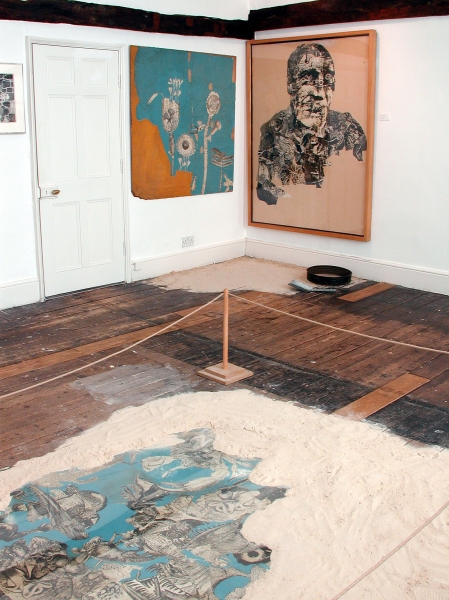
Installation view of Nigel Henderson retrospective at Gainsborough’s House, Sudbury, Suffolk, 2001. Photograph shows Nigel Henderson’s Head of a Man (1956) and Collage for ‘Patio and Pavilion’ (the growth of plant forms) (1956). The flooring and sand in the foreground are a detail from the reconstruction of Patio& Pavilion (1956), (2001/1956), Nigel Henderson, Eduardo Paolozzi, Alison Smithson, Peter Smithson, Courtesy of Gainsborough’s House, Sudbury, Suffolk.
This is Tomorrow has not yet been replicated in its entirety. Instead, individual installations have been extracted, reproduced and inserted into new contexts. In 2001, the Patio & Pavilion exhibit was recreated for Nigel Henderson’s touring retrospective. Originally, Patio & Pavilion had been the work of Group 6: artists Nigel Henderson and Eduardo Paolozzi with architects Alison and Peter Smithson. Their installation had a post-apocalyptic aesthetic, comprising a yard area and makeshift hut with decorated flooring obscured by sand. In her 2001 show, curator Victoria Walsh recreated Group 6’s efforts, presenting her replica in Suffolk, Sheffield, Edinburgh and, finally, London. In London it was exhibited at the Architectural Association’s gallery in Bedford Square, less than three miles from its 1956 home in Whitechapel.
Similarly, the Fun House exhibit from This is Tomorrow reappeared in Richard Hamilton’s 2014 retrospective at Tate Modern. Originally the work of Group 2, the Fun House was a composite of blown-up Hollywood stills, images from science-fiction, advertising and reproductions of artworks. There was even a jukebox playing popular hits. Group 2 consisted of artists Richard Hamilton and John McHale and architect John Voelcker. Almost pre-empting the Fun House’s reconstruction, Voelcker wrote in the exhibition’s catalogue, “Tomorrow is released when experience of instants past contact this instant, here, now” (Voelcker in Crosby, 2010 [1956]: np). By replicating the Fun House Tate invited audiences to experience an “instant past,” or at least a fragment of that instant.
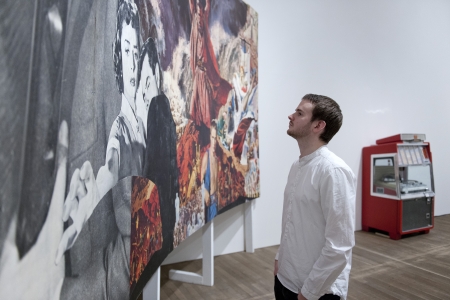
Installation view of Richard Hamilton retrospective at Tate Modern, London, 2014. Photographs shows Group 2’s Fun House installation at This is Tomorrow by Richard Hamilton, John Voelcker and John McHale (1956, reconstructed 1987) (2014 / 1987 / 1956), Richard Hamilton, John Voelcker and John McHale, © The estate of Richard Hamilton, Courtesy of Tate Photography
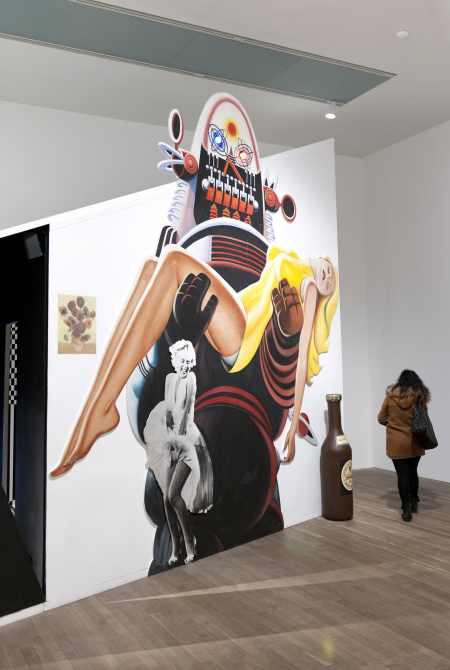
Installation view of Richard Hamilton retrospective at Tate Modern, London, 2014. Photographs shows Group 2’s Fun House installation at This is Tomorrow by Richard Hamilton, John Voelcker and John McHale (1956, reconstructed 1987) (2014 / 1987 / 1956), Richard Hamilton, John Voelcker and John McHale, © The estate of Richard Hamilton, Courtesy of Tate Photography
The Whitechapel Gallery itself has also invoked the remembering exhibition format. In 2010 they re-presented This is Tomorrow in archival form, exhibiting documentation, marketing material, correspondence and photographs that depicted the 1956 show. To complement this, they republished the catalogue, a facsimile of the original with the addition of a contemporary preface. In resisting any large-scale form of replication, the Whitechapel Gallery created a remembering exhibition in which remembering – or imagining – was central to the audience’s encounter. By presenting only archival material and a catalogue, they asked that viewers reconstruct the original exhibition mentally, using these clues to piece together an image of the original event. In doing so, the gallery re-inscribed This is Tomorrow into their own history, emphasising the show’s physical and historical location within the institution.
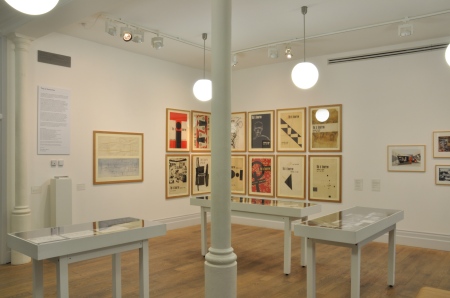
Installation view of This is Tomorrow exhibition held at the Whitechapel Gallery, 9 September 2010 – 6 March 2011. Courtesy of Whitechapel Gallery, Whitechapel Gallery Archive.
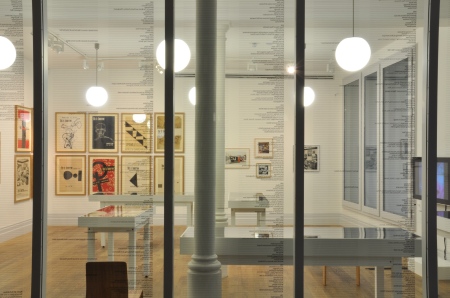
Installation view of This is Tomorrow exhibition held at the Whitechapel Gallery, 9 September 2010 – 6 March 2011. Courtesy of Whitechapel Gallery, Whitechapel Gallery Archive.
The second form of remembering exhibition discussed by Greenberg is the riff. In these instances, the original show is treated as a malleable construct. As Greenberg explains, “riffs involve recognising the importance of an exhibition or exhibition phenomenon and rethinking it in exhibition form” (Greenberg, 2009: np). This year alone, This is Tomorrow will be the subject of two exhibitions that riff off the original: This is Today at the Gazelli Art House in London and This was Tomorrow at the Kunstmuseum in Wolfsburg, Germany. Both these exhibitions invoke This is Tomorrow as a framing device and a historical mooring. Together they illustrate the extent to which This is Tomorrow has become a referent, shorthand for a particular moment in cultural history. In an extension of this logic, This is Tomorrow is now also the name of a contemporary art magazine, which claims no formal affiliation with the 1956 show other than drawing inspiration from its experimental ethos.
As is evident, This is Tomorrow no longer exists as a single moment. In its sixty-year life-span the show has fractured, transformed and spread into new contexts and broader cultural consciousness. This dispersion, however, is largely unwritten, with little mention of its reproductions in exhibition catalogues or textbooks. This is Tomorrow’s replicas and riffs are therefore at risk of being forgotten, eclipsed by the aura of the 1956 event. So what now? According to Greenberg, the only way to counter the ‘landmark’ status of the original is for for remembering exhibitions to remember themselves. She argues that the web makes this possible, “Past and future exhibitions re-presented on the web become a simultaneous present” (Greenberg, 2009: np). If This is Tomorrow can be said to invite one thing it is this: a simultaneous present composed of both past and future.

This was Tomorrow. Screenshot of the Kunstmuseum Wolfsburg’s website (2016), Courtesy of the Kunstmuseum Wolfsburg
In the catalogue’s opening paragraph Lawrence Alloway wrote, “yesterday’s tomorrow is not today” (Alloway in Crosby, 2010 [1956]: np). What could be more appropriate than the exhibition’s own histories paying testament to this statement? Here’s hoping that in the next sixty years, curators continue to reproduce and re-imagine This is Tomorrow, finding new ways to document this process online.
Rosie Ram
Rosie Ram works as Archivist and Collection Manager for the Nigel Henderson Estate; Researcher and Editor (Modern and Contemporary) for Thomas Williams Fine Art; and Programme and Operations Assistant at Chisenhale Gallery. Rosie’s academic background includes a postgraduate degree in Culture, Criticism and Curation from Central Saint Martins where she was awarded the Vice Chancellor’s Scholarship for Academic Excellence. In September 2016, Rosie will begin a doctorate at the Royal College of Art examining Nigel Henderson’s and Eduardo Paolozzi’s collaboration.
BIBLIOGRAPHY
Banham, Reyner, (1955), “The New Brutalism,” Architectural Review 118, no. 708: 355–361.
Banham, Reyner, (2011), “This is Tomorrow,” October 136: 32-34.
Crosby, Theo, ed. (2010 [1956]), This is Tomorrow. Whitechapel Gallery, London.
Daniel, Marko, and Hudek, Antony (2009), ‘Landmark Exhibitions Issue: Introduction’, Tate Papers, no.12, Autumn, http://www.tate.org.uk/research/publications/tate-papers/12/landmark-exhibitions-issue-introduction, accessed 22 July 2016.
Foster, Hal, Krauss, Rosalind, Bois, Yve-alain, and Buchloh, Benjamin H. D, (2004), Art Since 1900; Modernism Antimodernism Postmodernism. Thames and Hudson, London.
Godfrey, Mark, ed. (2014), Richard Hamilton. Tate Modern Exhibition Catalogues, London.
Greenberg, Reesa (2009), ‘‘Remembering Exhibitions’: From Point to Line to Web’, Tate Papers, no.12, Autumn, http://www.tate.org.uk/research/publications/tate-papers/12/remembering-exhibitions-from-point-to-line-to-web, accessed 22 July 2016.
Rajchman, John (2009), ‘Les Immatériaux or How to Construct the History of Exhibitions’, Tate Papers, no.12, Autumn, http://www.tate.org.uk/research/publications/tate-papers/12/les-immateriaux-or-how-to-construct-the-history-of-exhibitions, accessed 21 July 2016.
Walsh, Victoria, (2001), Parallel of Life and Art. Thames & Hudson, London.
Featured image: Installation view of This is Today at the Gazelli Art House, London. Photograph shows Eduardo Paolozzi sculpture in the foreground and Archigram vinyl in the background (2016), Eduardo Paolozzi, Archigram, Courtesy of the Gazelli Art House


Pingback: Salon des Refusés: Roxy Music | Societe Anonyme Inc
Pingback: Part three – Contextual study point 8 – Extending a line into space – Exploring Drawing Media